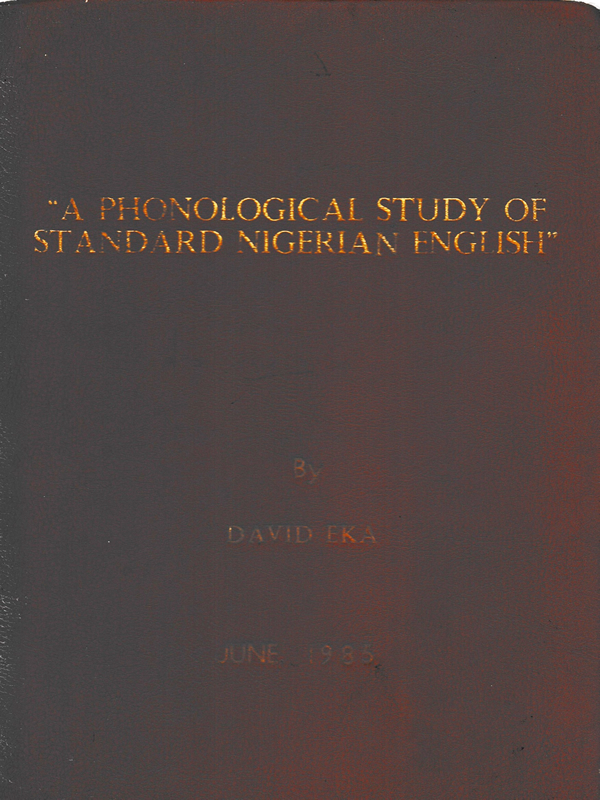A Phonological Study of Standard Nigerian English (Ph.D)
$50.00
ABSTRACT
This is a sociolinguistic study of the segmental and Nonsegmental Phonology of standard Nigerian English (SNE). It combines auditory perception with instrumental tracings called Oscillomink Records on an Oscillomink machine. It assumes the existence of a Nigerian English (NE) and identifies SNE as the speech of educated Nigerians; penultimate year Nigerian undergraduates studying English/or Education» The choice of the research area and of Informants is justified in the Introductory Chapters.
Chapter One introduces the main issues involved and gives a general direction and goals of the research. It discusses the background and the research problems; explains the choice of a Model for SNE and stipulates the Scope and Delimitation of the study. The chapter also reviews literature related to previous researches on NE and gives an overall justification for the study.
Chapter Two focuses on the Theoretical Framework and the Research Methodology. It briefly traces the early history of Phonology and discusses the Paradigms used in most recent works in the field. It stipulates the choice of a Model Framework and gives in detail the Procedures adopted in the study.
Chapter Three focused on an analysis of the segmental Phonology of SNE. It treats the classification, distribution and variant forms of SNE phonemes; the duration, weakening and simplification of vowels; consonant clusters, vowel/consonant combinations and dialectal (ethnolinguistic) variation.
Chapter Four treats the Nonsegmental features of SNE through the Parametrical Approach to Intonation Analysis. It analyzes the tones – types and tokens; the tone groups and their internal structure; the functions of tones; the rhythm of SNE and the factors which contribute generally to the type of melody that characterizes SNE speech.
Chapter Five summarizes the major findings features of SNE. It concludes by making recommendations and indicating directions for further research into NE. It also indicates Limitations of the study. The phonology of standard British English (SEE) is used for interpolation and Control throughout the investigation.
Description
TABLE OF CONTENTS
1. INTRODUCTION
1.0 Preamble
1.1 Statement of the Problem
1.2 Identifying Model Speakers of SNE
1.3 Scope and Delimitation of the Study
1.4 Review of Literature
1.5 Justification for the Study
Notes to Chapter
2. THEORETICAL FRAMEWORK/RESEARCH PROCEDURE
2.0 Preamble
2.1 Early History of Phonology – a Survey
2.2 The Primes of Analysis
2.2.1 Generative Phonology
2.2.2 Tagmemic Phonology
2.2.3 Prosodic Analysis
2.2.4 Distinctive Feature Analysis
2.2.5 Distributional Phono1ogy
2.3 A Model Framework
2.3.1 Jones‘ Concrete, Monosystemic Phonemic Model
2.3.2 American Modek;of Intonation Analysis
2.3.3 British Models of Intonation Analysis
2.3.4 Crystals Parametrical Model
2.4 Research Procedure
2.4.1 The Pilot study
2.4.2 Main Study
2.4.3 Processing of Data
Preservation of Tapes
Notes to Chapter 2
3 SEGMENTAL PHONOLOGY OF SNE
3.0 Preamble to Analysis
3.1 The Phonemes – General
3.1.1 SNE Vowel Phonemes
3.1.2 Vowel Realization/Distribution
3.1.3 Vowel Variants/Alternants in SNE
3.1.4 SNE Vowel Quality
3.1.5 SNE Vowel Charts
3.1.6 Duration in SNE Vowels
3.1.7 “Weak” Vowels in SNE
3.1.8 Vowel Simplification in SNE
3.2 SNE Consonant Phonemes
3.2.1 Consonant Realization/Distribution
3.2.2 Consonant Variants in SNE
3.2.3 Consonant Clusters in SNE
3.3 Vowel and consonant Combinations in SNE
3.4 Frequency of Phonemes in SNE
3.5 Preamble to Discussion
3.5.1 SNE Vowel Variants/Alternants
3.5.2 SNE Vowel Quality
3.5.3 Duration in SNE Vocal
3.5.4 The Issues of Coalescence and Vowel length in SNE?
3.5.5 Vowel Simplification in SNE
3.5.6 Consonant Variants
3.5.7 Consonant Clustens
3.5.8 SNE Phonotactic System
3.5.9 Frequency of Phonemes in SNE
3.5.10 Dialeotal (ethnolinguistic) Variation
Notes to Chapter 3
4 NONSEGMENTAL PHONOLQGY OF SNE
4.0 Premble to analysis
4.1 The Tones
4.1.1 Tone Types/Tone Tokens
4.1.2 Tone Groups
4.1.3 Internal struoture of the Tone Group in SNE
4.1.4 Functions of Tones in SNE
4.2 Rhythm of SNE
4.2.1 Syllable Prominence
4.2.2 Tempo in SNE
4.2.3 Continuity in SNE
4.3 Pitch in SNE
4.4 Loudness in SNE
4.5 Preamble to Discussion
4.5.1 Tone Types/Tokens
4.5.2 Tone Groups
4.5.3 Internal structure of the Tone Group in SHE

Prof. David Eka
Late Prof David Eka was an erudite Professor of English with more than 42 years experience. As a scholar who specialized in The Phonology of English, Sociolinguistics, General Phonetics, Applied Linguistics and Use of English/Language Planning, he had lectured and imparted knowledge to many in several Institutions across the nation and beyond. He held professional memberships in some bodies some of which includes Literary Society of Nigeria. A major part of his career had been with the University of Uyo, where he lectured and held several responsibilities within the Faculty of Arts and the University at large. He lectured 7 Undergraduate Courses, 4 Postgraduate Courses and supervised several Undergraduate and Postgraduate projects, thesis and dissertations.
He has authored several books, book chapters and journal articles, many of which can can be accessed on this website. He has been the Chief Editor to the Journal of Humanities for several volumes. He was a Ruling Elder in the Presbyterian Church. He is blessed with a beautiful family.
He is late now, but his works lives on.
Questions and Answers
You are not logged in
